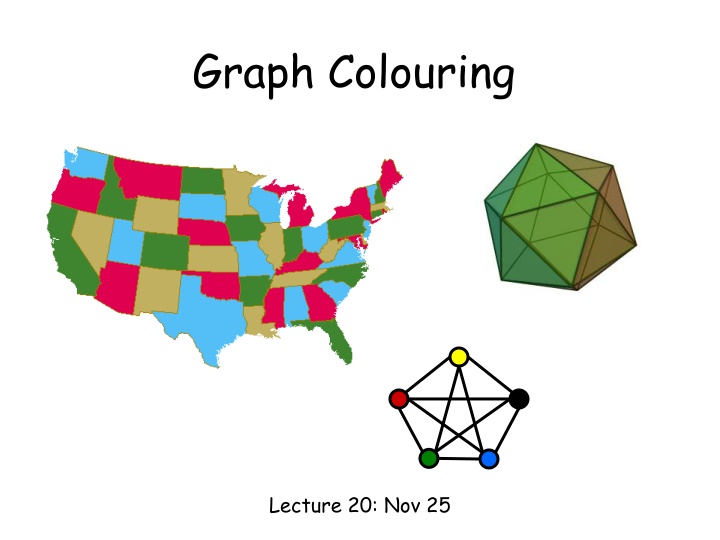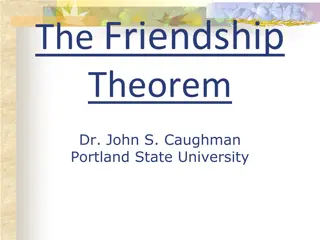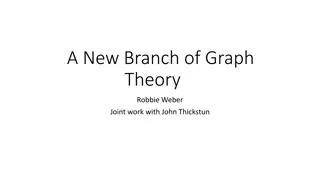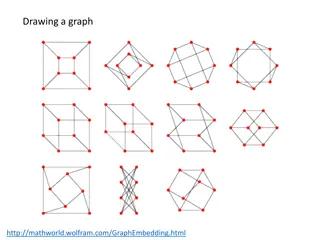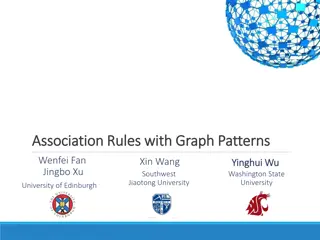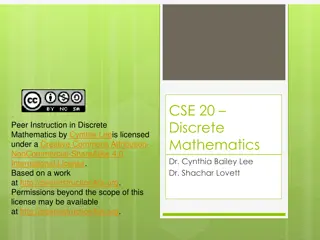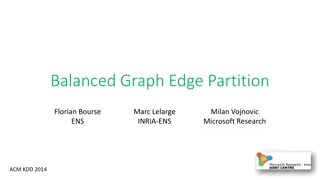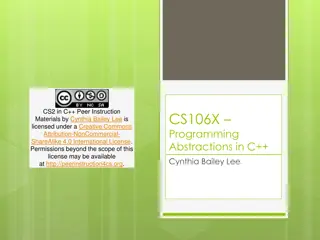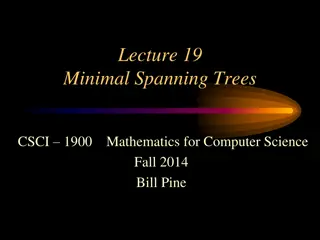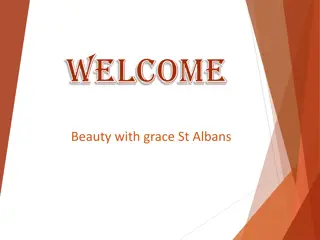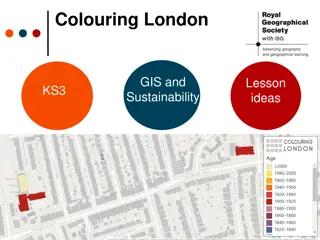Graph Colouring in Theory
Graph colouring is a vital problem in graph theory with applications like solving the 4-color problem. Learn about chromatic numbers, colouring strategies for various graphs, and the concepts of bipartite graphs. Explore the intricacies of 2-colourable and bipartite graphs, and understand their characteristics like odd cycles and the relationship between 2-colourability and bipartiteness
Download Presentation

Please find below an Image/Link to download the presentation.
The content on the website is provided AS IS for your information and personal use only. It may not be sold, licensed, or shared on other websites without obtaining consent from the author.If you encounter any issues during the download, it is possible that the publisher has removed the file from their server.
You are allowed to download the files provided on this website for personal or commercial use, subject to the condition that they are used lawfully. All files are the property of their respective owners.
The content on the website is provided AS IS for your information and personal use only. It may not be sold, licensed, or shared on other websites without obtaining consent from the author.
E N D
Presentation Transcript
Graph Colouring Lecture 20: Nov 25
This Lecture Graph coloring is another important problem in graph theory. It also has many applications, including the famous 4-color problem. Graph coloring Applications Planar graphs
Graph Colouring Graph Colouring Problem: Given a graph, colour all the vertices so that two adjacent vertices get different colours. Objective: use minimum number of colours. 3-colourable
Optimal Colouring Definition. min #colors for G is chromatic number, (G) What graphs have chromatic number one? when there are no edges What graphs have chromatic number 2? What graphs have chromatic number larger than 2? A path? A cycle? A triangle?
Simple Cycles (C )= 2 even (C )= 3 odd
Complete Graphs (K )= n n
Wheels W 5 (W )= 4 (W )= 3 even odd
Trees root Pick any vertex as root. if (unique) path from root is even length: odd length: Can prove more formally using induction.
2-Colourable Graphs When exactly is a graph 2-colourable? This is 2-colourable. 2 colourable: tree, even cycle, etc. Not 2 colourable: triangle, odd cycle, etc.
Bipartite Graphs When exactly is a graph 2-colourable? Is a bipartite graph 2-colourable? Is a 2-colourable graph bipartite? Fact. A graph is 2-colourable if and only if it is bipartite.
Bipartite Graphs When exactly is a graph bipartite? Can a bipartite graph has an odd cycle? NO If a graph does not have an odd cycle, then it is bipartite?
Bipartite Graphs When exactly is a graph bipartite? No such edge because no 5-cycle 1. The idea is like colouring a tree. 2. Pick a vertex v, colour it red. 3. Colour all its neighbour green. 4. Colour all neighbours of green vertices red 5. Repeat until all vertices are coloured. No such edge because no triangle If a graph does not have an odd cycle, then it is bipartite? Theorem. A graph is bipartite if and only if it has no odd cycle.
Chromatic Number How do we estimate the chromatic number of a graph? If there is a complete subgraph of size k, then we need at least k colours? YES Is the converse true? If a graph has no complete subgraph of size 4, then we can colour it using 4 colours? NO What graphs are 3-colourable? No one knows a good characterization
This Lecture Graph coloring Applications Planar graphs
Flight Gates flights need gates, but times overlap. how many gates needed? time 122 145 Flights 67 257 306 99
Conflict Graph Needs gate at same time 145 Each vertex represents a flight 306 Each edge represents a conflict 99
Graph Colouring 257 122 145 67 306 9 There is a k-colouring in this graph iff the flights can be scheduled using k gates. => If there is a schedule, the flights scheduled at the same gate have no conflict, and so we can colour the graph by using one colour for flights in each gate. <= If there is a graph colouring, then the vertices using each colour have no conflict, and so we can schedule the flights having the same colour in one gate.
Colouring the Vertices 257 122 145 assign gates: 67 306 257, 67 122,145 99 306 4 colors 4 gates 99
Better Colouring 257 122 145 67 306 3 colors 3 gates 99
Final Exams subjects conflict if student takes both, so need different time slots. how short an exam period? This is a graph colouring problem. Each vertex is a course, two courses have an edge if there is a conflict. The graph has a k-colouring if and only if the exams can be scheduled in k days.
Graph Colouring 8.02 6.042 18.02 assign times: 3.091 M 9am M 1pm 4 time slots (best possible) T 9am 6.001 T 1pm
Register Allocation Given a program, we want to execute it as quick as possible. Calculations can be done most quickly if the values are stored in registers. But registers are very expensive, and there are only a few in a computer. Therefore we need to use the registers efficiently. This is a graph colouring problem.
Register Allocation Each vertex is a variable. Two variables have a conflict if they cannot be put into the same register. a and b cannot use the same register, because they store different values. c and d cannot use the same register otherwise the value of c is overwritten. Each colour corresponds to a register.
Good News For some special graphs, we know exactly when they are k-colourable. Interval graphs (conflict graphs of intervals): b b d d a a c c For interval graphs, minimum number of colours need = maximum size of a complete subgraph So the flight gate problem and the register allocation can be solved.
This Lecture Graph coloring Applications Planar graphs
Map Colouring Colour the map using minimum number of colours so that two countries sharing a border are assigned different colours.
Map Colouring Can we draw a map so that there are 5 countries such that any two of which are adjacent? NO Can we draw a map which need 5 colours? NO Conjecture (1852) Every map is 4-colourable. Proof by Kempe 1879, an error is found 11 years later. (Kempe 1879) Every map is 5-colourable. Theorem (Apple Haken 1977). Every map is 4-colourable. The proof is computer assisted, some mathematics are still not happy.
Planar Graphs - Each vertex is a region. - Two regions have an edge if they are adjacent. This is a planar graph. A graph is planar if there is a way to draw it in the plane without edges crossing.
Non-Planar Graphs Can we draw a map so that there are 5 countries such that any two of which are adjacent? NO
Four Continuous Faces An important concept of a planar graph is its faces. So let s study it in some details. II II IV I 4 Connected Regions
Region Boundaries b a c d
Region Boundaries abca b a c d
Region Boundaries abca b abda a c d
Region Boundaries abca b abda a c acda d outer region
Region Boundaries abca b abda a bcdb c acda d outer region
Region Boundaries: Bridge f b c e a efge abcda g d abcefgecda outer region
Region Boundaries: Dongle s y r x v t w rstur outer region u
Region Boundaries: Dongle s y r x v t w u
Region Boundaries: Dongle s stvxyxvwvturs y r x v t w rstur u
Planar Embeddings A planar embedding is a graph along with its face boundaries: cycles (same graph may have different embeddings) length 7 face two length 5 faces
Eulers Formula If a connected planar graph has v vertices, e edges, and f faces, then v e +f = 2 v=5, e=5, f=2 v=6, e=10, f=6 v=9, e=8, f=1
Proof of Eulers Formula If a connected planar graph has v vertices, e edges, and f faces, then v e +f = 2 Proof by induction on the number of vertices. Base case (v=1): v=1 f=e+1
Proof of Eulers Formula If a connected planar graph has v vertices, e edges, and f faces, then v e +f = 2 Induction step (v>1): contract the red edge v =v-1, e =e-1, f =f Number of faces is the same, although some faces get shorter. By induction, v -e +f =2. This implies v-e+f=2.
Application of Eulers Formula Claim. If G is a simple planar graph with at least 3 vertices, then e <= 3v-6 Let be the face lengths. Note that because each edge contributes 2 to the sum Contributes one to two faces Contributes two to one face
Application of Eulers Formula Claim. If G is a simple planar graph with at least 3 vertices, then e <= 3v-6 Let be the face lengths. Note that Since the graph is simple, each face is of length at least 3. So Since e = v+f-2, this implies
Application of Eulers Formula Claim. If G is a simple planar graph with at least 3 vertices, then e <= 3v-6 Claim. Every simple planar graph has a vertex of degree at most 5. 1. Suppose every vertex has degree at least 6. 2. Then e >= 6v/2 = 3v. 3. A contradiction.
6-Colouring Planar Graphs Claim. Every simple planar graph has a vertex of degree at most 5. Theorem. Every planar graph is 6-colourable. v 1. Proof by induction on the number of vertices. 2. Let v be a vertex of degree at most 5. 3. Remove v from the planar graph G. 4. Note that G-v is still a planar graph. 5. By induction, G-v is 6-colourable. 6. Since v has at most 5 neighbours, 7. v can always choose a colour (from the 6 colours). G-v
Application of Eulers Formula Can we draw a map so that there are 5 countries such that any two of which are adjacent? NO Can this graph have a planar drawing? Claim. If G is a simple planar graph with at least 3 vertices, then e <= 3v-6 This graph has v=5 and e=10, and so does not satisfy the claim.
